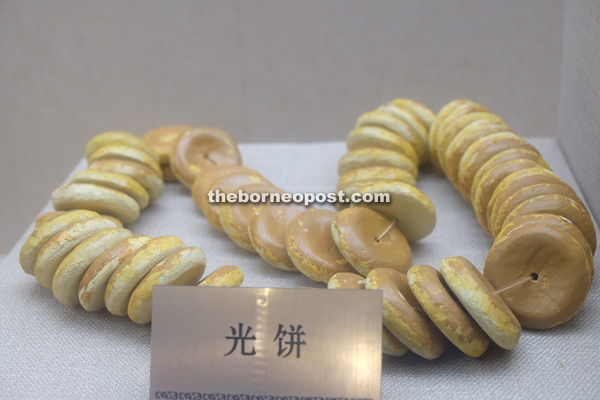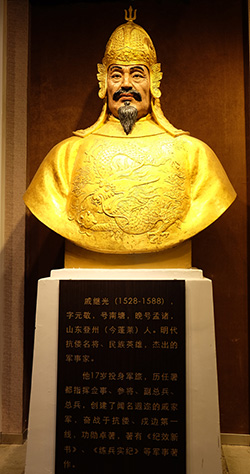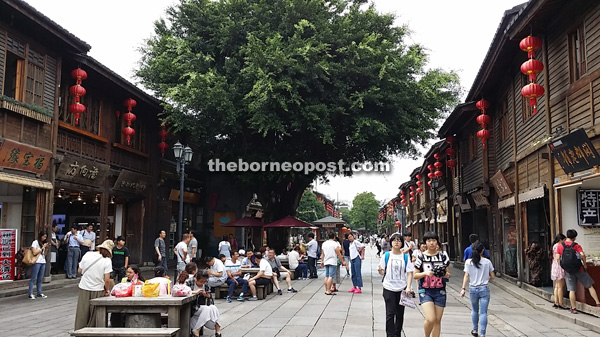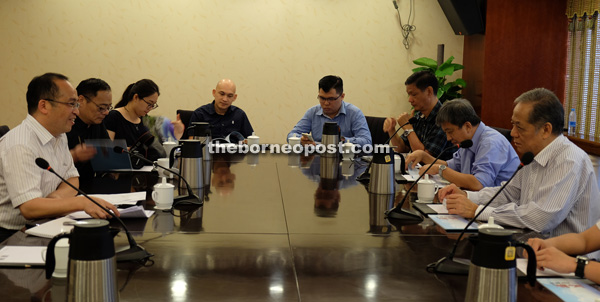
How ‘kom pia’ look like in those days.
The Lin Zexu Memorial Hall which honours Fuzhou’s favourite son who led the China’s war against the opium trade is the main historical building in the area.
Lin is recognised as one of China’s national heroes for his leading role in the First Opium War (1839-1842).
Besides bringing the trading of opium to a halt, Lin was also well-known for his water conservation projects and for his promotion of learning from the Western powers.

Statue of Qi ‘the father of kompia’.
The origin of ‘kom pia’
In Sarawak ‘kom pia’ the Foochow pastry with a hole in the middle is one of the signature foods of Sibu but few people know its history and the reason for the hole in the middle.
We found out the origin when we visited Yushan (Yu mountain) exhibition hall dedicated Qi Jiguang – the ‘father of kom pia’.
Qi was a Chinese military general of Ming Dynasty who led Ming forces to defend China’s east coastal regions from raids by the Japanese invaders in the 16th century.
The hall commemorates the military achievements of Qi and one of the exhibits is a string of kom pia.
Qi came up with the novel idea of tying the army ration round the neck of his soldiers in the battlefront to allow for ease of movement.
To do that, he developed a simple recipe for kom pia, a pastry with a hole in the middle for the string to pass through.
After the war the people took a liking for this army ration and it became a popular food in Fuzhou. The Foochow migrants from the area brought it with them when they settled in Sibu.

A view at San Fang Qi Xiang (Three Lane Seven Alleys), in the heart of Fuzhou city.
Fujian Daily Group
Our delegation also visited Fujian Daily Group which publishes 11 papers with a staff 3000 employees.
Du ring our dialogue session Fujian Daily’s deputy editor-in-chief Pan Xianqiang the newspaper industry in China is not spared from the universal challenge of on-line news and media practitioners in Fujian province convene once a year to deliberate issues and challenges faced by the industry.
Fujian Daily first published in 1949 with only news reports and then evolved to include advertisements and keeping up with time in 2002, Fujian Daily Group went online.
The Foreign Affairs Office of Fujian Provincial People’s Government. In Fuzhou, the Foreign Affairs Office of Fujian Provincial People’s Government hosted a luncheon following a dialogue with us.
Director of consular and cultural of the office Luo Guansheng asserted that a four-day trip in Fujian province would not satisfy any traveller as cities in the province had a lot more to offer. For instances, Anxi is renowned for tea leaves, Xiamen for its automobile industry and Yongchun for mandarin oranges.
Luo, who has been to Sarawak twice, remembered the Land of the Hornbills as a state rich in natural resources.
He also recalled meetings which touched on agriculture-related collaboration between Sarawak and Fujian. Luo also revealed that the Malaysia, Singapore and Thailand are among the top destinations for tourists from Fujian.
Maritime and Aviation Museum
This is where we briefly learned about the naval and aviation history of China. When it comes to China’s shipping affairs, one of the important names to be registered is Zuo Zongtang.
Zuo realised that the Western warships were superior to the Chinese warships at that time and appealed to the Qing government to set learn from the foreigners the technology of modern ship building.
He is the founder of China’s modern shipping industry.
Our brief visit to Fuzhou made feel the close affinity between this ancient Southern Chinese city and Sarawak.

Luo (left) at a simple meeting with us in Fuzhou.
